If you’re deep into electric the guitar world or just doing your first steps in there, the best wireless guitar system is the purchase to make things simpler. It makes you think about music, not about cables around.
The wireless set for guitar playing usually consists of two devices sending and receiving the signal on the same frequency and thus, delivering the guitar signal to the amp without the cord. While this helps sparу the cable interference and makу the performance stage safer (no unplugged or broken cord hazard), the wireless transmission of the sound signal has its own issues. Thus, the guitar wireless systems differ by many parameters, the most important of which make:
- Type of signal. The analog systems valued for the rich tonality, perform the companding to send the signal. The digital systems encode the soundwave and send it without further treatment, which results in zero interference of the amp output. The type of signal also determines the working range of frequencies (from VHF to Wi-Fi).
- Range. The sets have a different range of action. The more you move around the stage (or the farther your amp is from you), the larger action range will be required from the wireless system.
- Controls. Some sets feature minimal controls, while others allow you to tweak the EQ and even change the frequency range customizing the device for the particular setup.
Consider these basic parameters and check the detailed descriptions below to choose your best guitar wireless system! Rock on!
Wireless Guitar System Reviews
Xvive U2
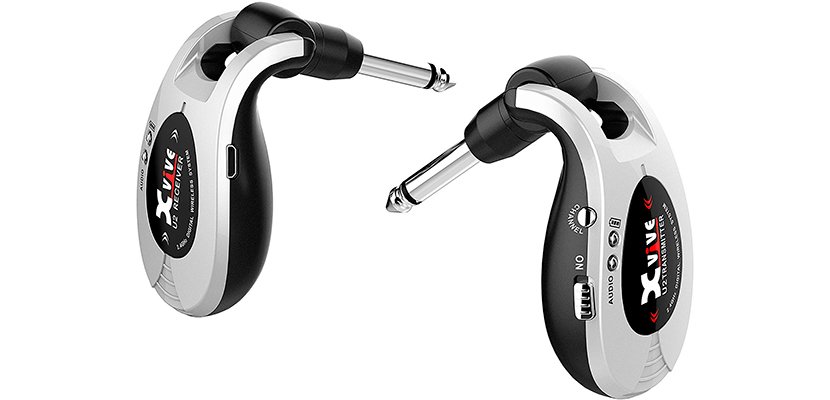
Large frequency range maintained, four channels for signal transmission, solid 70 ft range, minimal latency, and tone affection make this set claim the best wireless guitar system position. However, its performance depends highly on a battery level — when the latter is down, the sound becomes buzzy and features dropouts at a long shot distance.
The set works on the band of 2.4 GHz, which provides for signal protection from radio and mobile connectivity waves. Still, to avoid RF or other wireless interference issues (e.g. when several wireless sets are used simultaneously), there are four different channels available to switch between.
Overall, the sound is clean and has good power, fully comparable to the cabled connection. The tone is unchanged, the crunchy riffs and melodic ballads are transmitted fully, without loss of detail or volume dropout. The system maintains a high-quality signal within the 20 Hz – 20 kHz frequency range and is consistent throughout.
The latency, declared by the manufacturer, makes 6ms, which is almost untraceable by the human ear. This ensures the adequate and full transmission of the most dynamic phrases, without loss of sound saturation and harmonics.
The Xvive U2 guitar wireless system is very compact while having a rugged body and sturdy connection jacks. The latter are of swivelling type ensuring tight fit into most of guitar and bass types. Still, some specifically located narrow inputs (like for Ibanez guitars) might not fit well.
Pros
- Good battery capacity and performance; lasts for 4 hours of constant work.
- Quick plug-n-play setup, automatic pairing, easy-to-use switches.
- Rubber padding on the backside keeps the guitar body unscratched.
Cons
- No single switch for turn on/off (might forget one piece switched on).
- Red LED light for battery status might be distracting.
Video Xvive U2
Ammoon 4 Channels
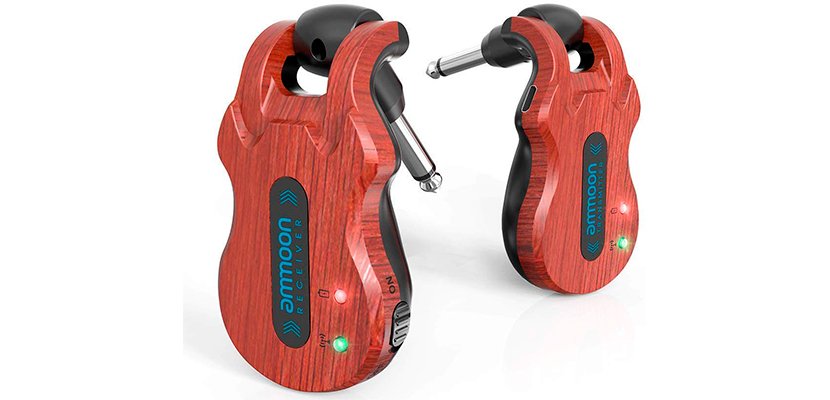
This wireless set is chosen by professional and amateur guitar- and bass players for good working distance, extended frequency response, and high dynamic range. For that, it could claim the title of the best wireless system for guitar. Still, the sustained notes might feature some digital interference, especially when played quietly; so, the lead guitar output might become compressed.
The system is tuned to work on a high band of 5.8 GHz ensuring the least affected signal transmission. While the working Wi-Fi router close to the set might introduce a slight buzz, the sound isn’t distorted by mobile connection or radio waves, as well as many other wireless systems. The signal is transferred onto the 300 ft area meaning the player is free to move around. Besides, should any interference or power issues appear, the system can be switched to one of the four channels it maintains.
The sound is converted into the 24-bit resolution on 48 kHz frequency enabling a crisp output. The maintained frequency range reaches 22 kHz providing non-screaming consistent highs. Meanwhile, the bass also comes full and rocking, with a clean dynamic thump. The dynamic range features 110 dB as upper limit ensuring the solid detailed sound flow on high volume, without dropout or squelching issues.
The Ammoon wireless guitar system features a compact design while having good weight and build. The standard connection jack can be rotated up to 220 degrees enabling different connection angle. The pairing is quick and trouble-free, performed automatically upon turning on both the receiver and transmitter items. The LED lights show the battery status while charging and the connection / signal strength.
Pros
- No lag in any of the four channels supported.
- Simultaneous receiver and transmitter charging through the dual USB cable.
- Appealing vintage design.
Cons
- Battery life shortens at constant usage.
- No visual difference between the transmitter and receiver.
Video Ammoon 4 Channels
Getaria Digital
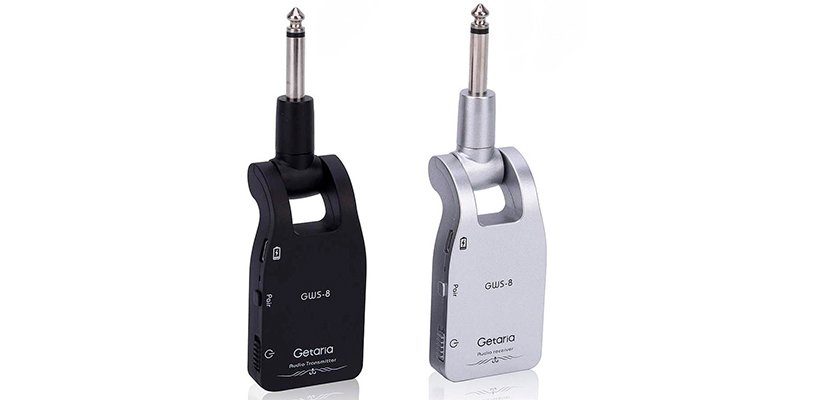
Connect your bass, guitar, keyboard, or any other musical instrument with equally strong signal and interference-free sound. That’s what alone could win the award of the best wireless bass guitar system for this set. Still, at extreme volume / frequency limit, the noise can be slightly heard, which might become a deal breaker for “purist” guitar players.
The operational band is the 2.4 GHz common for wireless music systems. Still, this unit has good signal protection letting it stay unaffected by “passing by” other high-frequency signals. 6 pairs of Getaria digital can be used simultaneously without issues and providing a strong non-distorted signal for each instrument / pedal board.
The sound is transferred with no noticeable lag and remains crisp even when playing complex compositions with hard riffs and multiple variations. There’s no loss in terms of tone and detail, the highs remain sharp and the lows solid and creeping. In general, the music sounds full and accurate, maintaining good tonal balance.
The signal transfer length reaches 100 ft and can even work through the wall (reducing the distance to 40 ft). The dynamic range exceeds 105 dB letting the guitarist play at the maximum volume without quality loss.
The Getaria wireless bass guitar system implements the rechargeable lithium battery that serves the system for several hours. Charging is quick and simple with the two-end USB cord. The transmitter and receiver are lightweight and have the extended degree of jack rotation (280 degrees) letting plug it into differently shaped sockets at various positions.
Pros
- The transmitter can send a consistent clean signal up to 6 receivers simultaneously.
- Good frequency response throughout the entire range.
- Different color coding for transmitter and receiver items.
Cons
- The pairing LED light is a bit too bright and can be distracting.
- The plastic body feels cheap and fragile.
Video Getaria Digital
Ammoon 6 Channels
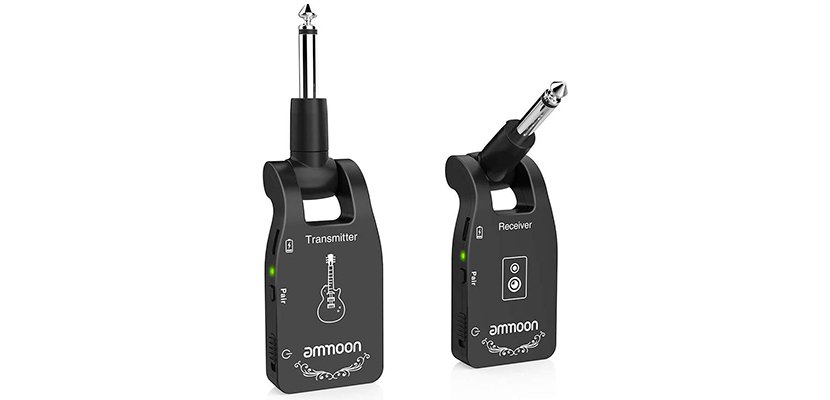
Good working distance, high-quality sound with a good sampling rate and resolution, broad frequency range and 6-channel support don’t make the list of the full advantages of this model. Combined with the lucrative price (at least three times less than competitors with the same functions), it could easily be praised as the best cheap wireless guitar system. Still, slight latency present, while untraceable by listeners, could be caught by the picky player’s ear and become an irritating factor.
The set sends and receives the signal within the 2.4 GHz band providing a 6-channel option for switching, in case the selected channel is already “occupied” by another wireless system. It also supports non-interfering sound transmission to 6 receivers simultaneously, without noticeable loss to sound quality or change to the tone.
The unit maintains a high-frequency range of 20 to 20,000 Hz, while the lower frequencies sound more solid and balanced than the highs. The mids are passed on as intended, without distortion and interference or digital aftertaste. Overall, the sound has good detail and precision, while the 105 dB lets wind up the volume without bothering about dropout or distortion / buzzing issues.
The set works well within 50 ft range, while its overall outreach distance makes up to 100 ft. However, at a further distance, the sound quality deteriorates slightly featuring noise and cutouts can be present.
The receiver and transmitter of this wireless guitar system are very lightweight and feature the versatile 280-degree rotating connection jack fitting most electric guitar types.
Pros
- Good battery capacity, provides solid performance for more than 2 hours of constant playing.
- Quick setup, pairs within seconds.
- Sturdy body casing and jack rotating part.
Cons
- Pairing isn’t automatic (requires pressing the button to connect).
- Limited manual instructions.
Video Ammoon 6 Channels
Shure GLXD16-Z2
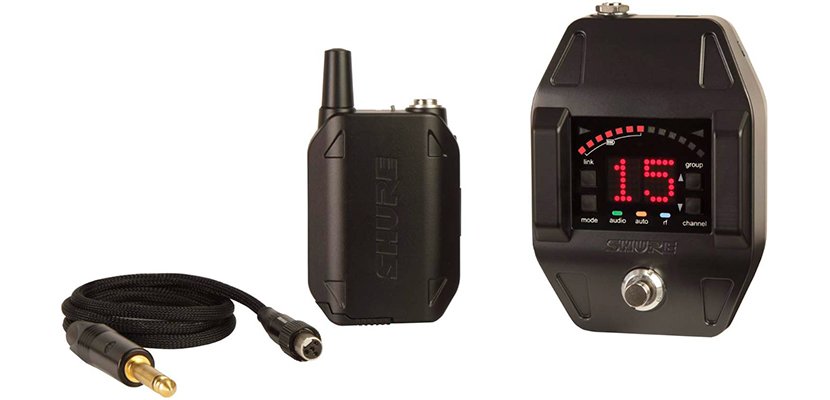
The key features of the Shure GLXD16 review are the following: comprise of innovative technology for frequency selection, smart battery handling, large outreach distance, and crystal clear sound. Still, the price is quite high, while justified by the functionality. Another issue, the device might be an overkill for beginners or players not using a lot of gear in their music sets.
The system operates within a 2.4 GHz frequency band while implementing the automatic frequency selection technology (LINKFREQ). The latter allows the unit to switch between available channels once there’s the slightest interference detected.
The sound goes full and clean, precise and balanced. Both lows and highs are consistent and rich in detail, while mids are rock solid revealing the richness of the melodic variations or crunchiness of metal riffs.
The receiver has the incorporated tuner letting set the pedal frequency easily by means of strobe or needle meter adjustment. The display shows the wireless signal strength or the tuner mode at a time. The operating distance between the transmitter and receiver makes up to 200 ft indoors (without obstacles, and about 100 ft outdoors, while the sound remains equally strong and clear throughout the coverage area.
The Shure wireless guitar system is highly versatile and can operate simultaneously with up to 8 systems of the same type or with the compatible ones. It also implements the smart technology for battery discharge and charging, enabling the set to last within 16 hours on end.
Pros
- The settings are memorized for each transmitter during simultaneous usage.
- Immediate automatic syncing upon activating the system.
- Solid body and parts build, made of metal.
Cons
- The transmitter isn’t plugged in directly into the guitar but through the short cable (supplied).
- Receiver’s jack doesn’t ensure tight connection, while not being loose as well.
Video Shure GLXD16-Z2
Mefe 4 Channel
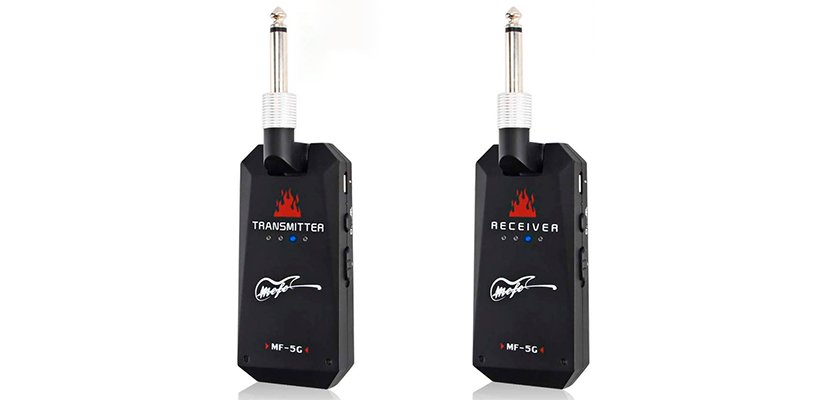
Both beginners and professional players will value the high-quality sound transmission, good “throw” distance and strong battery of this wireless guitar system. Meanwhile, the connection jack design doesn’t allow it to enter fully into the input port of some guitar models leaving the receiver kind of flapping around the guitar.
This wireless set acts on the 5.8 GHz band making it immune to the majority of interference sources. There’s a selection of 4 working channels to ensure noise-free signal passthrough.
The signal is captured fully within the standard 20 Hz – 20 kHz range and comes out of the amp clear and well-composed. There is no distortion or deviation, while the overall harmonical composition is transmitted precisely. The highs are well balanced and clean, the mids are expansive and dynamic, and so is the bass. Overall THD+N for this unit makes -98 dB providing no noticeable noise to the signal.
The operating distance for this guitar wireless system makes up to 100 ft within line of sight, and half of that with obstacles present (walls, closed doors, etc). While the optimal signal quality is reached within 30 ft from the receiver, the noticeable latency and noise appear only close to the outreach limit. The performance quality also depends on a battery state, being the highest at full charge.
Pros
- 1100 MAh battery provides up to 8 hours of continuous playing.
- Highly responsive, the latency is less than 2 ms.
- Comprehensive layout and color-coding of LED lights make it easy to track the connection / channel / battery status.
Cons
- The physical size of the transmitter is rather big making it protrude behind the guitar’s edge (so, there’s a risk of hitting it against the leg and unplug).
- Slight tone coloration is present.
Video Mefe 4 Channel
ZXK CO Set
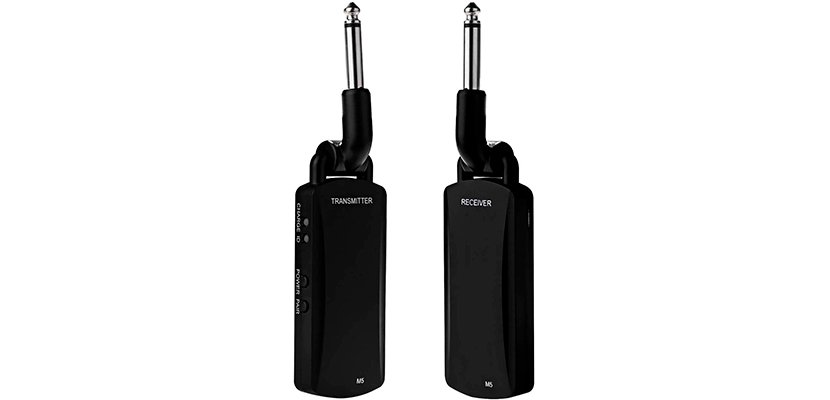
This set is a good example of high-quality wireless sound transmission. It has next to no latency, long connection distance and active frequency-changing tech. Meanwhile, both units of the device aren’t compact as most of the competitors, and pose a threat of knocking them down or bumping into something during the play.
The system sends the signal within a 5.8 GHz band, which provides a wide choice of frequencies (there are four channels supported by the set, to select from). The signal goes crisp and loud, not marred with interference from other sources. The set maintains simultaneous operation with 3 other sets of the kind, without signal interchange or noise issues.
The set implements the active frequency changing technology present in the more expensive models. It lets the system change the channel once the interference is detected, and go “hopping” on channels until the free one is reached.
The signal quality is high; it’s transferred in 24-bit resolution and at a 48 kHz sampling rate. The output has good balance and detail and preserves the initial dynamics. All the frequencies are transmitted precisely, without coloration. The signal stays strong at 7 dBm; the overall distance of sound transmission makes up to 150 ft (clear sight).
The guitar wireless system is equipped with a decent battery enabling the 5 hours of playing with the low-middle power. The included battery has a low environmental impact and takes about 1 hour to charge fully.
Pros
- Works well with the bass with active pickups (adds no interference / shriek sound).
- Latency is next to zero and is untraceable in the majority of cases.
- Consistent signal throughout the volume / distance range, no dropouts / fading issues.
Cons
- Transmitter and receiver are hard to discern visually (same shape & color).
- When played at high power, the battery drains quickly.
Video ZXK CO Set
NUX B-2
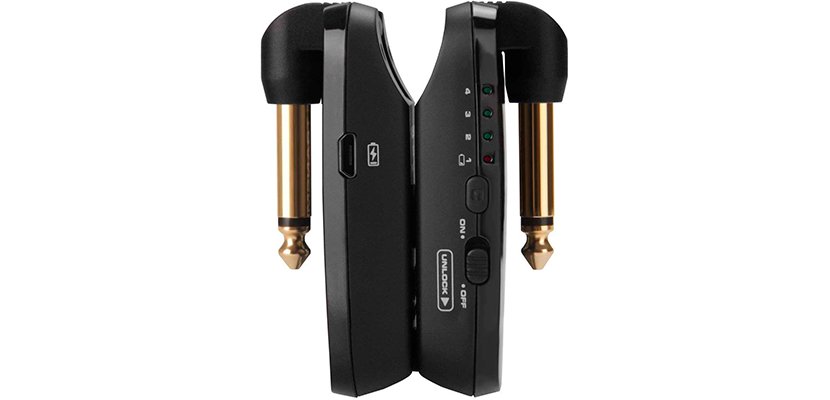
If you need the high-definition sound with plenty of detail and accurate performance and are ready to pay the middle-level price, consider this wireless system for guitars as a worthy entry to your shopping list. Still, its instruments range is limited to the passive type only, which might become a deal breaker for bassists having active pickups on their instruments.
The wireless band for this set is 2.4 GHz one, which cuts efficiently the cellular / mobile and TV/ radio signals but is also susceptible to Wi-Fi routers transmission. Still, the transmitter and receiver maintain 4 channels; thus, a free one can be chosen for the guitar / amp passthrough.
The set works in the 20 – 20,000 Hz range and the accustomed sampling rate of 48 kHz. It transmits the sound in 32-bit coding ensuring the preservation of a good amount of detail and sound depth. The frequency response is highly consistent both at extreme ends and on middle frequencies. The sound flows naturally and uncompressed, with good balance and precision, without any digital noise or fading frequencies.
Compared to other guitar wireless systems, the set features very low latency that falls below 5 ms. This means it’s non-discernible even by the pickiest players and listeners. The overall sound dynamics are transmitted accurately, with a lot of punch and power. 110 dB and more of the dynamic range make up for clear representation of all frequency levels even at the volume being wound up.
The transmitter and receiver have a handy low-profile design and are equipped with the swiveling jacks to fit the majority of guitar port configuration.
Pros
- Simple intuitive setup and controls.
- Solid climate-proof build.
- Good battery life and fast replenishing.
Cons
- With protruding guitar ports, the jack mightn’t fit tightly.
- At a low battery level, signal dropout might appear.
Video NUX B-2
Mefe MS -1
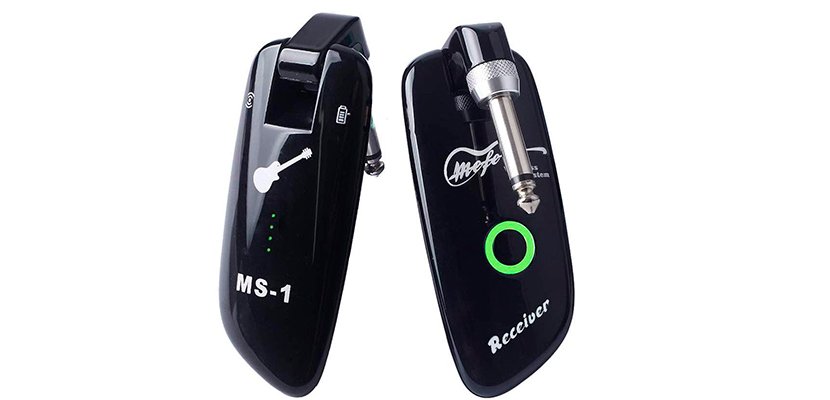
High level of signal protection and bottom-low latency, as well as considerable battery life mark this cordless set among other wireless guitar systems. Still, the extended charging time mightn’t fit long rehearsals or gigs with short breaks in the performance.
This cable-free set works on the UHF band and as such, can select up to 100 channels for the signal passthrough. Though channels might catch the radio waves occasionally, the wide choice of channels lets find the suitable one for almost any type of location / environment. It also means the guitar system can work simultaneously with multiple other wireless sets including hands-free, music instrument systems, etc.
The sound signal being free from the outer interference comes uncompressed, in the good sampling rate and 24-bit format. It maintains a strong impact throughout the performance and doesn’t fade with volume increase. While the frequency range is slightly narrower than that of competitors, the sound output features high clarity and integrity, with solid punchy lows and accurate non-pitched highs on the electric guitar.
The set recreates the sound precisely and immediately, the latency being damping low even for the premium models. It takes less than 2 ms and is completely absent to the human ear.
The included power bank has 800 MAh and lets the system work trouble-free for 6 hours on end. The LED lighting shows the charge level and flashes when the latter is too low. The unit has a sleek modern design, with a lighted LED button working as the activation / inactivation switch and channel selector.
Pros
- 165 ft active range, without signal cutout or distortion.
- Fits active pickup sets.
- 220-degree adjustable plug and low item profile ensure a tight connection with the majority of guitar / bass ports.
Cons
- Heavier than similar sets.
- Bass performance is a bit too bright and lacks bottom-deep tones.
Video Mefe MS -1
Buyer’s Guide
Why Would I Use A Guitar Wireless System?
The cabled connection served guitar and bass players well throughout the decades ensuing consistent strong signal with little interference. However, cables often came in the way when the players moved limiting the freedom of self-expression. The player should have been always aware of the cable, other musicians and objects on stage. Even at home or on rehearsals, the cable could be dragged by someone’s foot and get unplugged or cause weird sound and pop. Besides, the longer the cable is, the weaker and muddier the signal arrives at the output.
A solution in today’s world of wireless TVs, vacuum cleaners and even car-bound systems is obviously a wireless signal passthrough from guitar to the amp. No cable in the way, freedom of motion and surprisingly, same or even surpassing quality of the sound — the latter going companding-free through the wireless band.
Analog Or Digital
As with most things concerning music, the guitar wireless sets have come a way from analog to digital. Basically, the analog vs digital difference adds up to the following:
- Sound transmission. The analog devices compress the sound to send it along and the receiver expands it to the required output level. A good deal of the tone can be lost, and the frequency range narrows respectively. Meanwhile, the digital systems convert the signal on one end and decode it on the other skipping the companding stage. The sound comes clean and interference-free.
- Latency. The companding in analog systems is performed immediately, while other factors might increase the delay. In digital systems, the converter works for at least 2 ms (more common, for 5-6 ms). This delay is too small to be picked by the listener’s ear, while it can irritate the player not hearing what he or she plays at once.
- Cable effects. Some players and music lovers consider the clean signal of the digital passthrough too colorless, missing the cable capacitance effects.
Companding and digital conversion
Compressing the sound signal and sending it along the channel causes frequency range loss, especially at the lower end, and accumulation of interference from radio waves. The signal expansion at the receiver’s end cuts the lower end further and might aggravate the acquired noise. Tonality might also be affected by getting too bright or building up unwanted harmonics. These issues become obvious when comparing the analog wireless output to the cable-bound one.
The digital conversion requires the A/D converter to transform the sound wave into the binary sequences. This process can be described in the sampling rate and bit depth terms. The sampling rate shows how many samples of the sound are fixed per one second, while the bit depth means the number of bits within each sample. The more the number, the more detail will be encoded and subsequently output on another end, dynamic range preserved.
Frequency bands
Analog and digital systems work on different frequency bands. This entails a smaller or bigger number of channels supported and varying level of interference risk.
The analog sets transmit the data on VHF and UHF bands, in total occupying the range of 30 HZ – 3 GHz. Such frequencies let choose from a large number of channels (for instance, it can be 100 channels for UHF). This means several sets of similar equipment can work simultaneously in close proximity, without interfering with each other.
However, the VHF and UHF frequencies are also used a lot by other transmitting stations including TV, radio broadcasting, cellular / mobile networks, individual connection (like on walkie-talkie gear). The UHF band of the two is less occupied and is used in the majority of the modern analog cordless sets for guitar. In some countries of the world, using the VHF and UHF channels requires having a license.
Digital signals are sent on higher frequency bands starting from 900 MHz channel. While not operating in the US, it’s widely used in Europe and other parts of the world. There are also 2.4 GHz and 5.8 GHz bands, which gained the most popularity for Internet transmission. They are license-free and available in most countries. Yet, the 2.4 GHz band is highly congested due to the Wi-Fi routers often being tuned on this frequency. That’s why the advanced guitar cordless sets implement the 5.8 GHz transmission channel. The negative of the digital transmission on higher frequency bands is the limited number of channels to switch between. It usually makes 4-6 channels, which is enough for most bands but might interfere with other wireless systems during concerts
Latency
Latency is the difference in time between the signal input and output. While the analog wireless connection is latency-free, the conversion of the digital signal takes time and results in the signal latency. It’s caused by the A/D converter encoding the sound wave into the binary code and then the decoding process performed by the converter in the receiver.
Modern digital systems implement high-quality converters that transform the 24-bit sound at a 48 kHz sampling rate within a few milliseconds. The average guitar wireless set features about 5-6 ms latency, while the advanced systems boast less than 2 ms delay.
Encryption
In order to protect the signal from interference and ensure solid drop-free connection, some of the wireless systems use the encryption technology. It blocks the channel access installing a code as the key. When both transmitter and receiver are connected to the channel, the signal goes fast and noise-free.

Hi everyone! I’m Thomas Moody, also known as Guitarzan.
